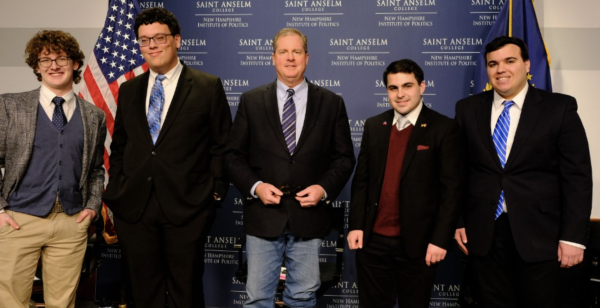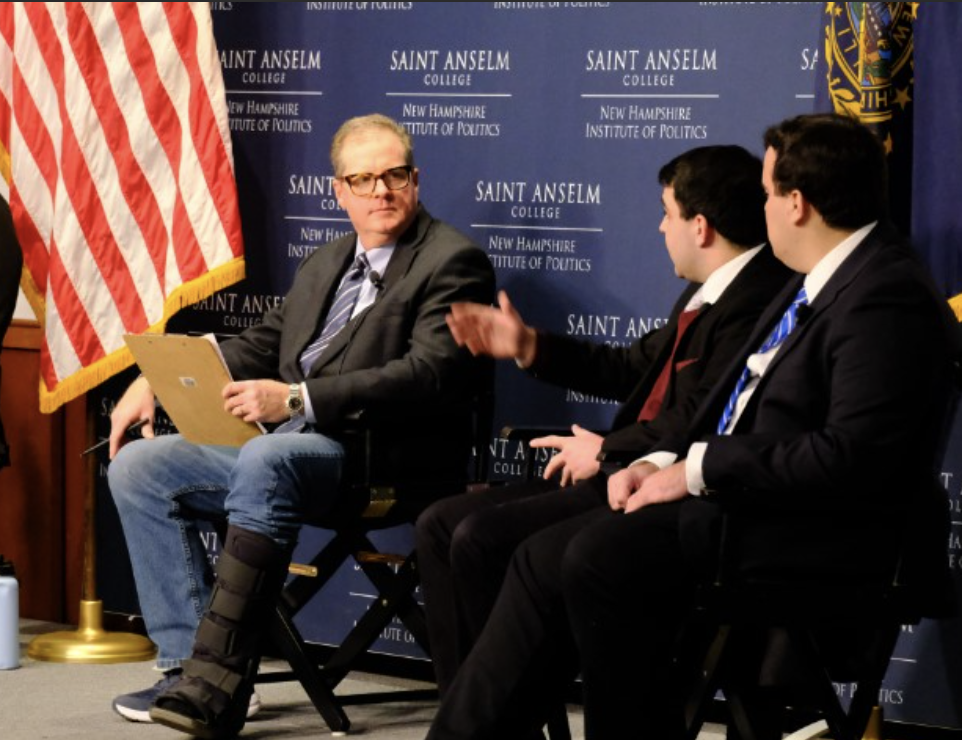The New Hampshire Institute of Politics held a formal debate between the College Republicans and Democrats for the first time. This unheard-of debate was an opportunity for the students to exercise their freedom of expression and share their political opinions. The Debate continues the effort of the NHIOP Ambassador Program to embrace and continue civil discourse.
Saint Anselm College, with the NHIOP, provided its students with a unique opportunity for political engagement. As the 2024 election draws near, the Deabte brings attention to the political sphere and climate of Saint Anselm College. Jaime and Mario, the two co-chairs of the Civic Engagement Committee, worked very hard to organize the debate. The two pioneered this event, working to create a platform of political engagement for students. Before the Debate started, the two stressed the importance of civil discourse.
The panelists consisted of four current students, two for each party. On the right was Anthony DiCenso, Executive Director of the College Republicans, and Mac Connors, Chairman. On the left was Kellan Barbee, Chair of the College Democrats, and Owen Bland, Treasurer and Secretary of the College’s Model United Nations, and the only Freshman panelist. The moderator of the Debate, was Executive Director of the NHIOP, Neil Levesque. Many members of the audience, although excited for the Debate, felt uneasy about the potential volatility. There was an obvious, underlying awareness that the debate could have lost its decency. Aside from a couple of jokes and one or two borderline ad hominem comments, the Debate remained “civilized.” An anonymous student said, “That went way better than what I expected was going to happen…I felt on edge the whole debate.”
The worry of volatility was especially abundant during the audience questioning section of the Debate. Neil, the NHIOP, and the organizers of the Debate stressed the importance of the avoidance of “hot topics” such as the Israel-Hammas conflict and abortion for audience questions. The Debate covered a variety of topics, covering a full range of the student’s opinions. Both sides were mostly moderate, and even in agreement on many of the points. The docket included issues on the Environment, the Drug Abuse Crisis, Foreign Aid, Student Loans, Election Transparency, the National Debt, Gun Rights, and the Death Penalty.
The audience was very engaged with the Debate and the panel. The audience questions interacted and continued conversations from the earlier discussions of the Debate. Some of these conversations extended by audience questions included the economic implications of foreign aid, the cultural dynamics of social media, the responsibility of younger generations with voting, and the importance of local politics. The Debate addressed the polarization and political divide that the country faces. Both sides of the panel addressed each other as “colleagues” and spoke with their views to specifically speak of the interests in America. Both sides agreed that change is needed.
The NHIOP emphasized the importance of the College Debate, representing young American views and their prospective hopes for the future. A core piece of the Debate addressed civil engagement being part of civil discourse. The Debate between the College Democrats and College Republicans is a symbol of the NHIOP. The Institute provides a bi-partisan platform for individuals and allows for issues to be discussed cooperatively. Like the NHIOP, the Debate challenged ideas and created discussion: a crucial component to the health of Democracy.



